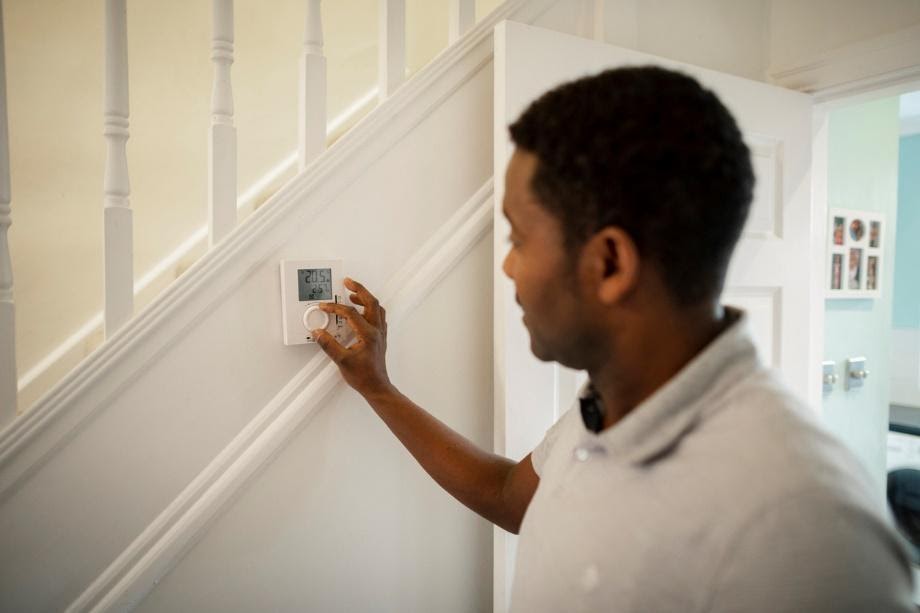A thermostat doesn’t just keep you warm or cool, but it affects your HVAC’s performance. Its accuracy or inaccuracy could impair your system’s ability to keep you comfortable and could negatively impact your utility bills.
Thermostats are not one-size-fits-all, and there is an assortment of thermostats that have different features and perform in different ways. If you’re wondering what the different types of thermostats are, this guide will help you choose one that best fits your needs and budget.
What is a Thermostat?
A thermostat is an apparatus that monitors air temperature and regulates it. Thermostats sense the ambient temperature, activate heating or cooling and run the HVAC until the desired setting is reached.
What are the Different Types of Thermostats?
There are four basic types of thermostats that are used in residential buildings.
- Mechanical Thermostats
Mechanical thermostats, also called manual thermostats, are very basic. They are often found in older homes. As the name suggests, you must set the temperature by hand, usually by turning a dial. Mechanical thermostats contain heat-sensitive metallic strips that respond to temperature variations. However, they are somewhat outdated because of their unreliable performance.
If you need help hooking up this thermostat, one of our technicians would be glad to install it for you.
Pros
- Inexpensive.
- Mechanical thermostats are very simple, so malfunctions are easy to diagnose.
- Easy to use.
- Long lifetime.
Cons
- Slow reaction to temperature changes.
- Minimal temperature control selections.
- Not programmable.
- Outdated.
- Programmable Thermostat
This type of digital thermostat can be set to adjust the temperature for daytime and nighttime. It also has daily and weekly settings. These are:
- Seven-day programs, which are seven separate programs for each day of the week.
- 5-2 programs, which are for the workweek and separate weekend programs.
- 5-1-1 programs, which are the workweek and different programming for Saturday and Sunday, each.
- One-week, which is the same programming for seven days.
In addition to these settings, you can also customize a schedule.
Pros
- Many temperature control and customization choices.
- Energy efficient.
- Protects your system from wear and tear.
- Quick response to temperature fluctuations.
Cons
- You have to manually set it up and program it yourself, which could be confusing.
- WiFi-Enabled Thermostats
WiFi thermostats connect to your wireless network and allow you to control your home’s temperature from an app on your tablet or smartphone. This provides you with the freedom to remotely control the thermostat without being anywhere near it.
A WiFi thermostat can be programmed, but you can also override the program from afar and create new settings. For instance, if you’re going to be home late from the gym, you can adjust your home’s temperature in the middle of your Zumba class.
Pros
- Sleek, modern look.
- You don’t have to be extremely tech-savvy to operate it.
- Can be installed quickly and easily.
Cons
- A WiFi-enabled thermostat can tell you when your home’s heat rises, but it won’t adjust the temperature accordingly. You have to do that yourself at your end.
- Smart Thermostat
Like a WiFi thermostat, a smart thermostat connects to your wireless internet network via an app on your smartphone or tablet. It’s called “smart” because it learns your daily habits and tweaks the temperature in response. If you set the temperature a certain way a certain number of times, the device stores information about these patterns for future use.
For instance, if you leave your house at 8 a.m. every day and come home at 4 p.m. in the summer, it will “learn” to cool the house while you’re home and reach a more moderate temperature while you’re out.
Some smart thermostats can be controlled by voice commands, provide energy usage reports and even alert you when you need to change your HVAC’s filter and when to schedule HVAC maintenance. Others are even smart enough to know when you’re coming home and will make the house comfy when you arrive!
Pros
- Improves energy efficiency.
- Compatible with other smart devices.
- Have a variety of climate controls.
Cons
- The most expensive thermostat.
- You need to be tech-savvy to use them.
- They can be hacked.
Which Thermostat Should I Get?
You may be poised to buy a thermostat, but before you do there are some important factors to keep in mind.
First, make sure that the model you are considering is compatible with your HVAC system. The manufacturer’s website should have this information.
Are you planning on installing it yourself? Even if you’re handy with electricity, you should have a professional install the more complex smart thermostat.
Also, consider your lifestyle and personal preferences. Do you like a lot of bells and whistles? Do you want something simpler? Do you have an irregular schedule or one that’s more consistent? How much automation do you want?
A thermostat can make the difference between a comfortable, welcoming home and one you merely endure. The highly skilled, knowledgeable professionals at Progressive Air Systems know what are the different types of thermostats and can help replace or repair yours. We respect and appreciate all of our customers, and value your business.
Contact Us
Please contact us today for assistance with your thermostat or any other HVAC needs!

